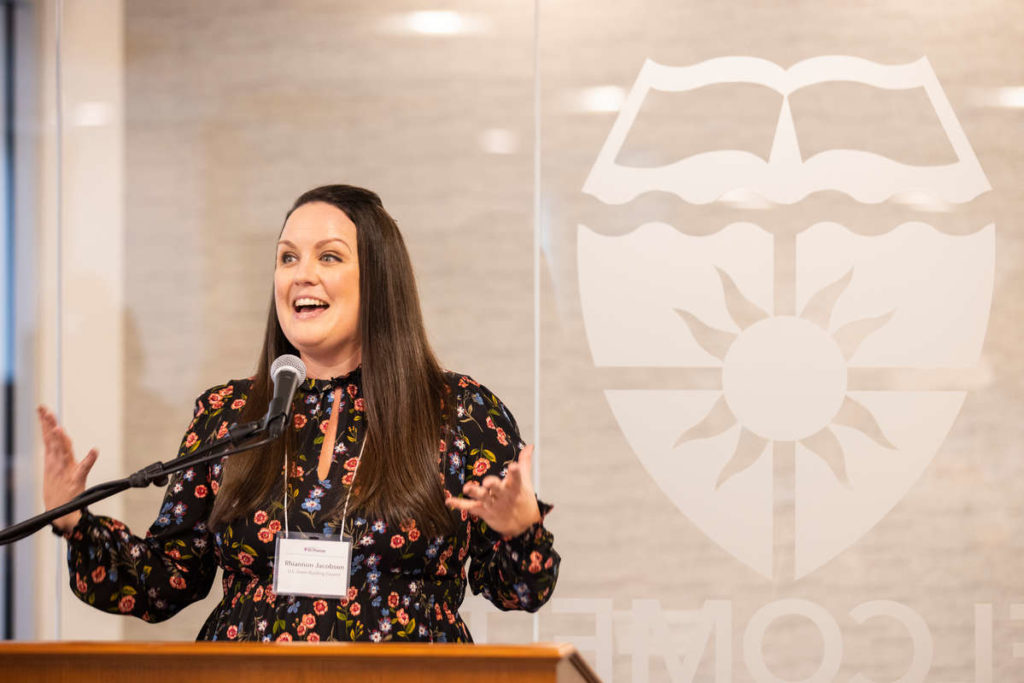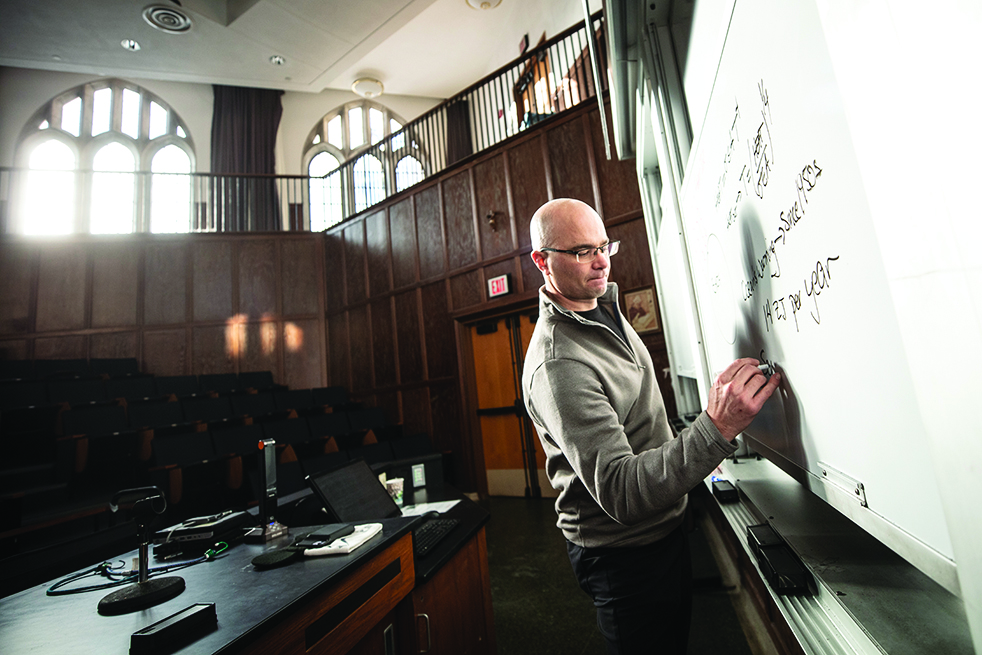Members of the St. Thomas community gathered at Tommie East on Nov. 8 to celebrate the residence hall's LEED Platinum certification as well as Tommie North's LEED Silver certification.
LEED (Leadership in Energy and Environmental Design), developed by the U.S. Green Building Council (USGBC), is the most widely used green building rating system in the world and an international symbol of excellence. All three of the most recent buildings constructed at St. Thomas, starting with the Anderson Student Center, have received LEED certification.
“This is part of a bigger picture at St. Thomas,” said President Julie Sullivan, noting that the United Nations COP26 climate summit also was taking place in Glasgow. “We are committed as a campus – whether it's in our educational programs, facilities, operations, policies, how we live and learn in and outside of the classroom – to sustainability.”
St. Thomas and its partners achieved LEED certification for implementing practical and measurable strategies and solutions in areas including sustainable site development, water savings, energy efficiency, materials selection and indoor environmental quality. LEED projects earn points by adhering to prerequisites and credits across nine measurements for building excellence from integrative design to human health to material use.
Tommie East received its LEED certification earlier in 2021, while Tommie North was recognized by the building council this September.
Tommie East is officially categorized under Building Design and Construction: Multifamily Midrise in the USGBC’s LEED database. Tommie North is categorized under Building Design and Construction: New Construction and Major Renovations in the database.
Tommie East was designed by ESG Architecture & Design and built by Ryan Companies. Tommie North was designed by Opus AE Group, LLC, and built by Opus Design Build, LLC.
“Sustainability is an important priority in the St. Thomas 2025 strategic plan and central to the university’s mission to advance the common good,” said Amir Nadav, director of sustainability. “Tommie North houses the Sustainability Living Learning Community, which connects first-year students to experiential learning both inside and outside of the classroom. The LEED certification advances our strategic plan, and reflects the university’s commitment to reduce our environmental impact while enhancing the student experience at St. Thomas.”

USGBC Vice President Rhiannon Jacobsen was on hand to celebrate with the St. Thomas community and its project partners.
“St. Thomas' commitment to LEED is a commendable leadership decision that represents a focus on sustainability, health, wellness and resiliency,” Jacobsen said. “LEED has redefined the way we think about the places where we live, work, play and worship.”
Lexi Shields '22, a Tommie East student resident adviser, said that she learned about sustainability during her first semester at St. Thomas in the Introduction to Justice and Peace Studies course, which prompted her to join the Sustainability Coalition.

“Sustainability on campus has come so far in just my time here ... I never would have believed that I would see this amount of progress during my time as a St. Thomas student, but the passion of our students and the unwavering support of our administration have made so much possible,” Shields said. “This has truly been a collaborative effort between past and present Tommies, faculty and administrators. I can't wait to see where we go next.”
Vice President of Facilities Management Jim Brummer said that the university has more than 547,000 square feet of space, representing 20% of the space on the St. Paul campus, that is LEED certified. “It's only going to grow from here,” he said.
Tommie North received high marks for several features, including:
- Three electric vehicle charging stations for student, faculty and visitor use
- 179 secured bike rack locations for student and faculty use
- 77% of all construction waste diverted to recycling facilities
- 45% water use reduction in comparison to the baseline design model
- 21% energy use reduction in comparison to the baseline design model
- All building finishes meeting low-VOC (volatile organic compounds) requirements
- Utilization of local material providers for rebar (Ambassador Steel) and stone (Vetter Stone – Mankato Kasota stone mix) to reduce carbon footprint
“Opus is pleased to be a partner with St. Thomas to advance our shared goals of sustainability through green construction,” said Opus Regional Vice President Beth Duyvejonck. “Tommie North is a prime example of using best practices to thoughtfully integrate sustainability goals into the program and design early, incorporating green building standards efficiently and without substantial increase to construction cost. Congratulations to St. Thomas for their impressive achievements in sustainability and conservation.”
Designing new buildings for LEED certification is part of the university’s larger plan to achieve carbon neutrality by 2035. Over the past decade, St. Thomas has reduced carbon emissions by 37%. The university is designing all new buildings larger than 25,000 square feet to a minimum of LEED Silver standards.
St. Thomas will be pursuing LEED Gold certification for its newest and largest academic building, the Schoenecker Center, meaning the university will have more than 700,000 square feet of LEED-certified space on campus.
St. Thomas has received numerous accolades for its commitment to sustainability. Four years ahead of the schedule outlined in St. Thomas 2025, St. Thomas earned a STARS (Sustainability Tracking, Assessment and Rating System) gold rating in recognition of its sustainability achievements. The university also is listed on the Princeton Review’s Guide to Green Colleges and has received three marks of distinction from the Climate Leadership Network. St. Thomas also recently was highlighted for the first time in the Association for the Advancement of Sustainability in Higher Education annual Sustainable Campus Index.







